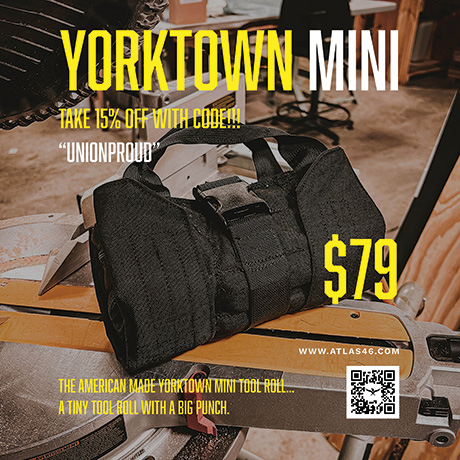Garment Workers showed the strength of working women
By ELLA WAGNER
National Park Service

The International Ladies’ Garment Workers’ Union (ILGWU) was one of the largest Labor unions in the United States in the 1900s. It represented hundreds of thousands of clothing industry workers, most of them women.
Two successful strikes in 1909 and 1910 won power for the union. Members and their allies pushed for new laws to protect Organized Labor. They gained broad support after the devastating Triangle Shirtwaist Factor Fire in 1911. By the 1920s, the ILGWU was a political heavyweight.
EARLY STRIKES
Seven local unions in New York City founded the ILGWU on June 3, 1900. Most of its members were young, immigrant women from Eastern and Southern Europe. Many of them were Jewish. The ILGWU cemented its power with two large strikes in New York City.
In 1909, 23-year-old Clara Lemlich galvanized a crowd of workers meeting at Cooper Union. She climbed up to the speakers’ platform and declared:
“I have no further patience for talk. I am a working girl, one of those striking against intolerable conditions. I am tired of listening to speakers who talk in generalities. I make a motion that we go out in a general strike!”
Later in life, she remembered her activism, saying “Ah… then I had fire in my mouth!”
Tens of thousands of workers agreed and joined Lemlich and other leaders like Rose Schneiderman on the picket line. The strike became known as the “Uprising of 20,000.”
At the time, it was the largest strike by women workers in U.S. history. The strikers demanded better hours, safer conditions, and fairer pay. They received support from a group of wealthy women who organized via the Women’s Trade Union League (WTUL).
Months later, 60,000 male and female cloakmakers walked out in another huge strike known as the “Great Revolt.”
AN INDUSTRIAL UNION
The ILGWU was an early example of an industrial union. All workers in an industry would join the same union, regardless of their individual jobs or skill sets. Supporters of industrial unionism argued that it would promote more unity and solidarity than the older style of craft unionism, which divided workers by their job function or skill levels.

– Bain News Service/ Library of Congress.
The strikes led to a spike in the ILGWU’s membership and forced major concessions from factory owners. But the Triangle Shirtwaist Factory fire the following year showed that much more was needed. – 146 garment workers died in the conflagration. Some of them had been trapped behind locked doors, a common management practice to reduce theft.
The uproar that followed the tragedy spurred important changes in labor law and enforcement. It galvanized leaders like Frances Perkins, who went on to shape the policies of the New Deal.
Under the leadership of longtime president David Dubinsky (1932-1966), the ILGWU more than doubled its membership. It expanded its geographic reach beyond the Northeast, and worked to organize Black, Latina and Asian employees in the South and West.
Unions were less common in these areas, and employer resistance could be fierce. But local leaders like Sue Ko Lee in San Francisco and Emma Tenavuca in San Antonio worked with the ILGWU to win improvements for their communities.
TENSION AT THE TOP
As the union grew and diversified, the disconnect between its leadership and its membership could be contentious. Leaders such as Rose Pesotta had long complained that the top leadership was almost exclusively male even though most members were women.
Pesotta, who led the grueling Dressmakers General Strike in Los Angeles in 1933, resigned from the ILGWU’s General Executive Board in 1942. Frustrated by the sexism she experienced from male leadership, she charged that the “men to whom I have been so useful” chose not to recognize her competence as a leader. As the racial diversity of the union increased, members of color demanded that they be represented too.
But the ILGWU also aspired to improve its members’ lives in ways that went beyond pay and working conditions. It developed workers’ education programs that trained members not only in the ins and outs of organizing a strike, but also in history, economics, and international relations. The ILGWU sponsored health clinics and invested in affordable housing. A resort in the Poconos, Unity House, hosted members for summer vacations.
The ILGWU made its mark on the arts and culture as well as politics. In the 1930s, it sponsored a satirical musical revue called “Pins and Needles.” Originally written as entertainment for strikers on picket lines, it starred a cast of garment workers and became a Broadway hit. It ran from 1937 until 1940 and was performed at the White House for Franklin and Eleanor Roosevelt in 1938. The revue commented on current events from a union perspective. Numbers like “Doing the Reactionary” and “Not Cricket to Picket” satirized bosses and fascist sympathizers. Its performers constantly revised and updated it in response to the news.
LATER YEARS
In the 1970s and 1980s, the garment industry in the U.S. began to decline as companies competed with cheaper imports from overseas. In response, the ILGWU mounted a campaign to encourage consumers to buy union-made American goods. In television commercials, workers sang a catchy song urging shoppers to “Look for the Union Label.”



Leave a Reply